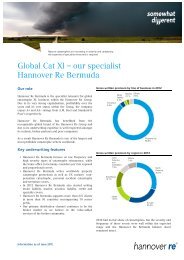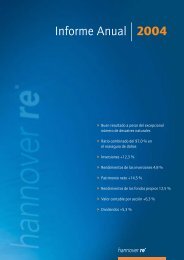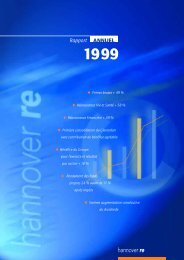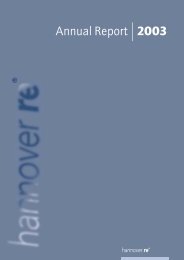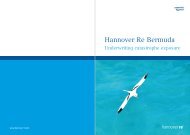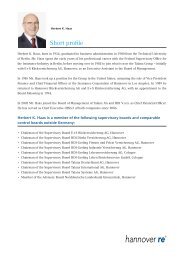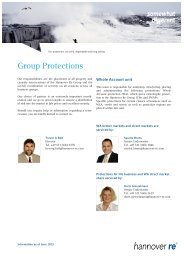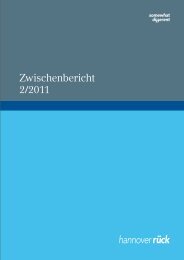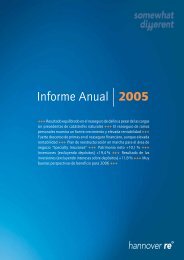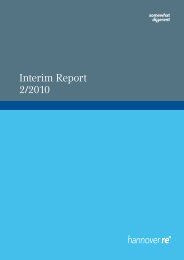Annual Report 2010 - Hannover Re
Annual Report 2010 - Hannover Re
Annual Report 2010 - Hannover Re
Create successful ePaper yourself
Turn your PDF publications into a flip-book with our unique Google optimized e-Paper software.
Segmental reporting: presentation of items from the annual<br />
financial statements separated according to function al criteria<br />
such as segments and regions.<br />
Special Purpose Entity (SPE): legal structure with specific<br />
characteristics not bound to a certain form of organisation<br />
used to conduct defined activities or to hold assets.<br />
Technical result: the balance of income and expenditure allocated<br />
to the insurance business and shown in the technical<br />
statement of income (after additional allowance is made for<br />
the allocation to/withdrawal from the equalisation reserve: net<br />
technical result).<br />
Treaty reinsurance: cf. obligatory reinsurance<br />
Specialty insurance: a specialty form of non-life primary insurance<br />
that focuses on narrowly defined, homogenous portfolios<br />
of niche or other non-standard risks (specialty business),<br />
whereby the typical insurer functions (acquisition, underwriting,<br />
policy issuing, premium collection, policy administration,<br />
claims settlement, etc.) can be outsourced to specialized managing<br />
general agents (MGAs) or third-party administrators<br />
(TPAs).<br />
Statement of Financial Accounting Standards, SFAS (also:<br />
Financial Accounting Standards, FAS): the accounting and<br />
reporting standards published by the Financial Account ing<br />
Standards Board; since 15 September 2009 superseded by<br />
FASB ASC.<br />
Spread loss treaty: treaty between an insurer and a reinsurer<br />
that covers risks of a defined portfolio over a multi-year<br />
period.<br />
Structured products: reinsurance with limited potential for<br />
profits and losses; the primary objective is to strive for risk<br />
equalisation over time and to stabilise the cedant’s balance<br />
sheet.<br />
Surplus reinsurance: form of proportional reinsurance under<br />
which the risk is not spread between the insurer and reinsurer<br />
on the basis of a previously agreed, set quota share.<br />
Instead, the insurer determines a maximum sum insured per<br />
risk up to which it is prepared to be liable. Risks that exceed<br />
the ceding company’s retention (surpluses) are borne by the<br />
reinsurer. The reinsurer’s lines thus vary according to the<br />
level of the retention and the sum insured of the reinsured<br />
contract. The reinsurer’s liability is gen erally limited to a multiple<br />
of the ceding company’s retention.<br />
Underwriting: process of examining, accepting or rejecting<br />
(re-)insurance risks and classifying those selected in order to<br />
charge the proper premium for each. The purpose of underwriting<br />
is to spread the risk among a pool of (re-)insureds in<br />
a manner that is equitable for the (re-) insureds and profitable<br />
for the (re-)insurer.<br />
Unearned premium reserve: cf. provision for unearned premiums<br />
US GAAP (United States Generally Accepted Accounting Principles):<br />
internationally recognised US accounting principles.<br />
Not all the provisions which together constitute US GAAP have<br />
been codified. In addition to the authoritative standards of the<br />
FASB ASC, US GAAP also includes, for example, standard<br />
accounting practices in specific industries.<br />
Value of in-force business (VIF): present value of expected<br />
future profit flows from the portfolio of in-force retained business,<br />
discounted by a currency-specific risk discount rate. It<br />
is determined in accordance with local accounting principles.<br />
Variable Interest Entity: legal entity not bound to a certain<br />
form of organisation for which the traditional approach to consolidation<br />
based on voting rights is ineffective in identifying<br />
where control of the entity really lies, or in which the equity<br />
investors do not bear the economic risks and rewards of the<br />
entity. The definition is broader than the previously used term<br />
special-purpose entity (SPE).<br />
Volatility: measure of the variability of stock prices, inter est<br />
rates and exchange rates. Standard practice is to meas ure the<br />
volatility of a stock price by calculating the stand ard deviations<br />
of relative price differences.<br />
Surplus relief treaty: a portfolio reinsurance contract under<br />
which an admitted reinsurer assumes (part of) a ceding company’s<br />
business to relieve stress on the cedant’s pol icyholders’<br />
surplus.<br />
xRoCA: cf.<br />
Excess <strong>Re</strong>turn on Capital Allocated<br />
Survival ratio: reflects the ratio of loss reserves to paid losses<br />
under a specific contract or several contracts in a balance<br />
sheet year.<br />
Further information<br />
<strong>Hannover</strong> <strong>Re</strong> Group annual report <strong>2010</strong><br />
Glossary<br />
201



